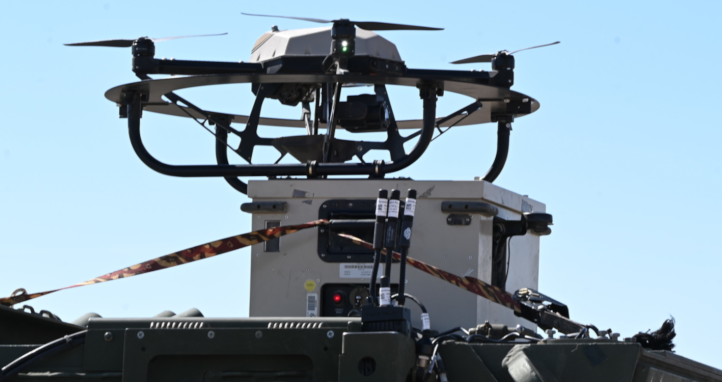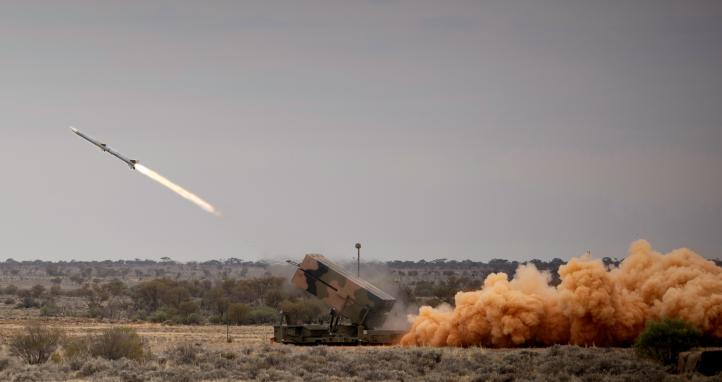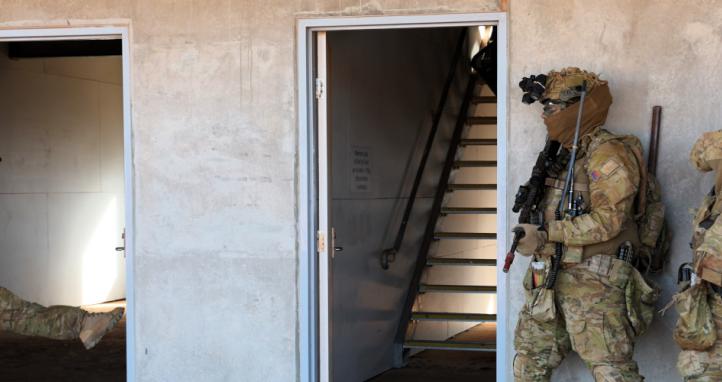| GDP | $USD 1,712.79 billions |
| GDP Per Capita: | $USD 33,121 |
| Currency | KRW (South Korean won ₩) |
| Imports | $USD 752.67 billions |
| Exports | $USD 753.55 billions |
| Main Industries | electronics, telecommunications |
The 'Know Your Region' series is designed to support unit and individual professional military education on the South East Asian region. It's important for all serving members of our military to have a foundational knowledge of the countries and issues in the Indo-Pacific.
THE KOREAS – ECONOMY
On this page:
REPUBLIC OF KOREA (ROK) – ECONOMY
- Summary
- Economy and GDP
- Trade Policies
- Foreign Investment and Aid
- Trade with Australia
DEMOCRATIC PEOPLE’S REPUBLIC OF KOREA (DPRK) – ECONOMY
- Summary
- Economy and GDP
- Trade with Australia
- Trade with Neighbours
- Trade with China
- Trade with Russia
ROK – ECONOMY
Summary
The ROK has achieved remarkable economic success. A poor society post-Korean War and WWII, it has grown to become an economically advanced country. Although it has experienced economic highs and lows, the ROK is now a stable democratic nation, a middle-power country and a global economic influence in trade.
ROK’s highly successful growth in productivity is driven by its national pride. The ROK is the third-largest exporter in the global market with command of ICT and technological goods. In 2019, South Korea’s Gross Domestic Product (GDP) was 12th in the world, 6th in total exports and 9th in total imports. This is a noteworthy economy considering it has a population of just 51 million. This link provides more details of ROK’s economic trends.
The following video provides a good introduction to ROK’s economic success:
Economy and GDP
The ROK’s exports account for more than 50% of its GDP. Despite the COVID-19 pandemic impact upon global exports, the ROK’s economy remains relatively strong. This year, The ROK’s GDP is expected to increase by 2.9% to 3.8% returning to a pre-pandemic level, and a further growth of 2.8% is expected in 2022.
Under President Moon’s administration, the economic focus has been to make a ‘people-centred economy’, with innovative investment as part of the focus for economic growth and prosperity. The ROK’s economic issues such as a low minimum wage, gender inequality in the workplace, and overall unemployment are expected to be addressed through the government’s implementation of ‘Korean New Deal’ which also includes investing in green power and areas of technology such as Artificial Intelligence. Furthermore, ROK is keen to take advantage of ‘soft power’ industries such as K-Pop for economic growth. This is highlighted in the following video:
For more information on ROK’s economy and GDP, see the resources below:
- Videos
- Why is South Korea so Rich? South Korea’s Economy
- S. Korea's plan to revitalise economy in second half of 2021
- World Economic Forum 2021: Economic perspective from President Moon Jae-In
- South Korea’s Natural Extinction – an Economic Problem
- BBC Documentary: South Korea The Silent Cultural superpower
- What can we learn from South Korean GDP?
- Podcast
- Articles
- Making the economy more vibrant and society more embracing
- ROK Economic Bulletin August 2021
- South Korea Economic Growth Statistics 2021
- South Korea Economic and Political Outline
- South Korea's economic growth expected to rebound by mid-2021: Moon
- S. Korea's Q1 growth estimated to have recovered to pre-pandemic level
- South Korea Shows OECD How It’s Done In Covid-19 Era
Trade
The ROK is a member of the World Trade Organisation and has many bilateral and multi-lateral trade agreements which include China, the USA and Australia, as well as regional and European countries. In total, ROK’s free trade agreements represent more than 70% of the global economy.
China is ROK’s biggest trading partner and receives 25% of all ROK’s export goods and services. These include machinery, chemical products, plastics and rubbers, and mineral products. The two countries share a bi-lateral trade agreement and are members of the Regional Comprehensive Economic Partnership, which is the largest free-trade agreement in the world.
The ROK is in an ongoing trade dispute with Japan, previously discussed in the KYR Japan series, and ROK trade with Australia is discussed in more detail further down the page.
For more information on ROK and trade, see the resources below:
- Videos
- Articles
Foreign Aid and Investment
As an economically successful middle-power, the ROK is now in a financial position to help other countries in need. In 2010, it became a member of the Organisation for Economic Co-operation and Development (OECD) which provides financial assistance to developing countries, and the Development Assistance Committee where members discuss issues of international aid focussing on inclusive and sustainable growth. The ROK has since donated significant financial aid to support health initiatives in third world countries and has also supported countries whose repayment of financial loans to the ROK has been hindered due to the COVID-19 pandemic.
For more information on ROK’s foreign aid and investment, see the resources below:
- Videos
- Articles
- South Korea's Foreign Aid: Evolution and Potential
- South Korean foreign aid: contributing to international security (2013)
- ROK pledge US$15 Million for education in developing countries
- The Impact of South Korea’s Foreign Aid
- South Korea – Donor Tracker
- South Korea’s foreign aid – evolution and potential
Trade with Australia
The ROK is Australia’s fourth-largest trade partner. In December 2014, the two nations signed a free trade agreement that has furthered trade opportunities and eliminated nearly all tariffs for goods and services between the two nations. As a result, the bilateral relationship has continued to strengthen, thus increasing opportunities for new trading opportunities.
The ROK predominantly imports coal, LNG, iron ore and beef from Australia, as well as agricultural products and food-related products totalling over AUD$28 billion. See the South Korean Country Profile for further statistics.
Into the future, ROK is seeking to work with Australia on green and digital investments, aerospace, automotive, shipbuilding, electronics and machinery exporters to supply ROK’s strong manufacturing base. These two websites detail the imports and exports Australia currently has with the ROK:
Australian exports to South Korea
Australian imports from South Korea
For further information on ROK’s trade with Australia, see the articles below:
- Articles
DPRK – ECONOMY
Summary
The DPRK is an independent socialist state with a command economy, which means the government controls all production of goods including type, quantity of production, growth, export and investment. The government also determines the price of goods: there is no competition against which to set prices as there would be in a free market economy. This website provides some insight into the differences between command and free market economies:
World Population Review Free Market and Command Economies
The DPRK’s economic goals are driven by government policies which focus on ‘juche’. When the country was established following the Korean War, its economy was centred on industry (particularly chemicals, metals, cement and machine tools) and military development, and much of this was under the Soviet Union’s governance model. The DPRK economy suffered significant upheaval following the collapse of the Soviet Union, as well as the impact of regular natural disasters and food shortages. In more recent times, the COVID-19 pandemic has impacted upon the country’s economy. In true ‘juche’ style, in 2020, the DPRK President Kim Jung-Un refused outside aid to support the country following severe floods and the pandemic. This more recent article provides current perspective on the DPRK’s refusal of humanitarian assistance.
Some of DPRK’s economic issues are discussed in the following video:
Economy and GDP
The DPRK economic targets are expected to be achieved within each cycle of the government’s five-year plans. Earlier this year, President Kim Jong Un announced the country’s next five-year plan (2021-2025) which included increasing productivity in chemical goods, iron and steel, industrial construction and mining. The plan emphasises the intent to achieve independent economic strength through self-reliance. Some sources suggest that the new plan will not achieve economic growth for the country: North Korea’s New Economic Plan Looks a Lot Like the Old One.
This video compares the economies of both of the Korean countries:
DPRK’s GDP fell last year by 4.5%, most likely as a result of recent natural disasters and COVID-19. According to the Bank of Korea, the GDP is the worst it has been for over 20 years. Over the last 10 years, according to some statistics, DPRK’s increase in GDP has been minimal compared to that of the ROK. In a recent video, the DPRK leader Kim Jong-Un admitted his economic plans had failed:
For more information on DPRK economy and GDP, see the following resources:
- Videos
- Podcasts
- Articles
- Defining a Command economy
- Great Programme for Struggle Leading Korean-style Socialist Construction to Fresh Victory
- The puzzle of North Korea and development cooperation
- North Korea’s economy sees biggest contraction in 23 years: South Korea Central Bank
- North Korea GDP Annual Growth Rate
- GDP Comparison North and South Korea from 2010 to 2019
- Economic Overview: North Korea
- Lowy Institute Asia Power Index: North Korea
- North Korea Tells Citizens to Prepare For a Famine Worse Than The 1990s
- North Korea Lifts Kaesong Lockdown, Rejects Foreign Aid
- Prospects for U.S. Humanitarian Aid to North Korea in the COVID Era
- North Korean leader Kim Jong-un compares economic woes to 1990s famine
- North Korea faces economic ruin amid food and medicine shortages
DPRK and Trade with Australia
The DPRK and Australia do not have any trade agreements. The trade relationship over the last 70 years has been sporadic and any steps in economic and diplomatic progress have been short-lived, although Australia has in the past provided financial aid to North Korea through various international programs. Australia currently follows the United Nations Security Council sanctions placed on the DPRK, which are detailed here by DFAT.
DPRK Trade with its Neighbours
The DPRK’s most significant trading partner is China, followed by Russia. Their importance to the DPRK differ both economically and strategically, and this video gives a basic understanding of the trading relationships:
DPRK Trade with China
As DPRK’s biggest trade partner, China consumes more than 90% of exported trade from the country. The DPRK is the major exporter of minerals to China and between 2009 and 2015, imports of Korean minerals increased by nearly 300%. This year; however, due to the COVID-19 pandemic, trade between the two countries has dropped by 84% according to Nikkei Asia.
While China has supported the DPRK through economic hardships in the past, the relationship has been strained by DPRK nuclear ambitions. In 2017, China banned all imports of coal from the DPRK and other goods for export in support of UN Security Council sanctions on the DPRK over its nuclear program. In 2020, the USA accused China of breaching the sanctions on the DPRK which China has denied.
The sanctions imposed on the DPRK prevented China exporting oil to its neighbour; however, this year, there is speculation that the two nations found a way to continue their trade relationship in oil since 2017. Read this article to compare trade data between the DPRK and China over a three year period.
For further information on the DPRK and China’s trade relationship, see the resources below:
- Videos
- Articles
- North Korea’s economy is recentralised and China-reliant
- Korean Institute for International Economic Policy: Impact of COVID-19 on China-North Korea trade relations 2020-2021
- Recovery of global trade: North Korea Vs China
- U.S. accuses China of 'flagrant' N.Korea violations
- China denies weakening sanctions enforcement on North Korea
- North Korean Oil Tanker stops in Chinese Port
- China’s Influence on the North Korean Economy
- The North Korean Economy, August 2019: Why China Will Continue to Dominate
- Traders in China prepare for a rush into North Korea, although sanctions remain
- North Korea’s economy is recentralised and China-reliant
- Four reasons why China supports North Korea
DPRK Trade with Russia
The economic relationship between the DPRK and Russia has varied over the last 30 years, starting with a near-freeze on trade in the 1990s after the collapse of the Soviet Union. While Russia has been of less economic importance to the DPRK than China, after Presidents Kim Jong-Un and Putin met for the first time in 2019, trade has increased. Russia’s largest export to the DPRK is crude oil; while in 2019, the DPRK’s largest export to Russia was musical instruments. In 2020, trade was halted when the DPRK closed its borders due to the pandemic.
Russia is expected to impose UN Security Council sanctions on the DPRK, although it has done so more subtly by, for example, stopping imports of DPRK metals of silver, tin, nickel and zinc, all of which are also produced in Russia. Other imports and export sanctions have not been enforced by Russia.
For further information on DPRK - Russia trade, see the resources below:
- Videos
- Articles
- Russia’s North Korea Policy: The Logic and Dilemma of Assisting North Korea
- Russian Trade With North Korea Increased 40% in 2019
- Where does the Russia-North Korea Relationship Stand?
- The Putin and Kim Rendezvous in Vladivostok: A Drive-By Summit
- Russian – North Korea Bilateral Trade Triples
- Russia, North Korea agree to step up trade after borders open — embassy
- As China-North Korea ties cool, Russia looks to benefit
Discussion Questions:
- As a major trading partner with Australia, the ROK requires access to the region’s maritime waterways to ensure trade can continue. Should Australia and the ROK do more to promote freedom of navigation within the region, such as through bilateral naval exercises? What strategic approach should the two nations take to maintain free access to waterways in the region?
- Trade sanctions against the DPRK have seemingly failed to reduce tensions around nuclear warfare capabilities. Is it time to look at other economic restrictions to seek DPRK government to reduce these nuclear ambitions, or does that simply increase suffering for the DPRK population?
- The ROK has numerous free-trade agreements with nations across the globe which amount to 70% of the world’s economy. Some of these agreements have facilitated increased export opportunities, which their GDP relies upon. Can Australia learn from the ROK’s approach to international trade? Are trade and international Defence alliances inherently linked, or can they be kept separate?
- The DPRK is located on a peninsula rich in mineral and natural resources. How can the region assist DPRK to develop its economy should tensions ease and the DPRK open up to the wider world?
- With an increasingly growing economy, the ROK is now considered a strong middle power, which has allowed it to be in a position where it can provide regular foreign aid. Should the ROK leverage this to have a greater power influence in the region? How can Australia work with the ROK to achieve this, and what sort of partnered efforts could occur?
- In the event of any Korean reunification, the DPRK will bring a significantly lower level of wealth and prosperity. Will reunification be beneficial to stability in the region and does that offer the ADF more opportunity with other partnerships?
Know your region
Know Your Region series gives you a shortcut to understanding other nations in the Indo-Pacific region.




